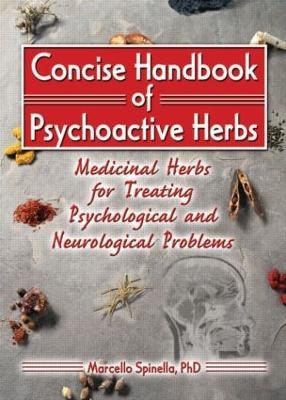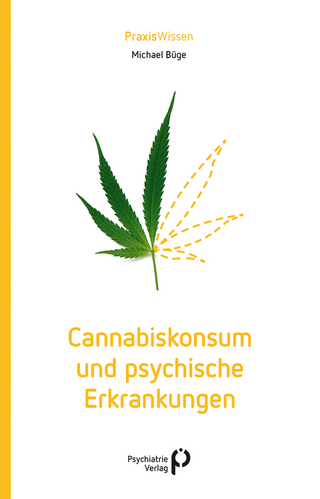
Concise Handbook of Psychoactive Herbs
Routledge (Verlag)
978-0-7890-1858-8 (ISBN)
Find out how plant-derived drugs react with your brain to produce either healing or harmful results!
The Concise Handbook of Psychoactive Herbs will give you a better understanding of herbal products that have psychological effects. The book explores how they work, how effective they are, and what is known about their safety. Geared towards non-specialist professionals and curious individuals, this guide shows how herbal preparations can affect the brain, mental state, and behavior of a user and includes treatment methods, tables, illustrations, a glossary, and a bibliography.
The Concise Handbook of Psychoactive Herbs contains chapters on several types of psychoactive herbs, including:
stimulants
cognition-enhancers
sedatives
painkillers
hallucinogens
With the Concise Handbook of Psychoactive Herbs, you’ll examine the effects of psychoactive drugs on the nervous systemboth positive and negative. Each chapter discusses a type of herbal medicine, its action on the brain and other systems of the body, side effects, and the potential for addiction. The book closely examines possible drug interactions with prescription medications and emphasizes the caution you need to take when using herbal health products.
In the Concise Handbook of Psychoactive Herbs you will learn about the psychoactive actions of such medicinal plants as:
coffee
tobacco
cannabis
ginseng
chamomile
cocoa
opium poppy
peyote
gingko biloba
Marcello Spinella
Chapter 1. Introduction
Plants As Medicines
The Use of Herbal Medicines
Why Do Plants Make Drugs?
How Humans Came to Use Herbal Medicines
The Science of Herbal Medicines
Summary
Chapter 2. How the Brain Works
Mind, Brain, and Behavior
Communication in and Between Neurons
Structure of the Nervous System
Chapter 3. How Drugs Work
How the Body Affects Drugs
How Drugs Affect the Body
Relationships Between Drug Doses and Effects
Chapter 4. Stimulant Herbs
Pharmaceutical Stimulants
Caffeine Stimulants
Tobacco and Tobacco-Like Stimulants
Amphetamine-Like Stimulants
Summary
Chapter 5. Cognition-Enhancing Herbs
Discussion and Treatment of Dementia
Ginkgo
Ginseng
Tobacco
Solanaceous Vegetables: Tomato, Potato, and Eggplant
Discussion and Treatment of Parkinson’s Disease
Fava Beans
Summary
Chapter 6. Sedative and Anti-Anxiety Herbs
The Problem of Anxiety
Insomnia
The Structure of Sleep
Central Nervous System Depressants
Valerian
Kava
Passionflower
Chamomile
Other Reputed Sedative Herbs
Summary
Chapter 7. Herbs for Mental Illnesses
The Era of Psychotherapeutic Drugs
Depression and Anxiety
St. John’s Wort
Ginger
Ginkgo
Schizophrenia and Psychosis
Chapter 8. Herbal Painkillers
What Is Pain?
The Pain Systems
The Analgesia System
Herbal Analgesics
Opium Poppy
Myrrh
Willow
Meadowsweet
Feverfew
Ginger
Chili Peppers
Stimulant Analgesics
Local Anesthetic Herbs
Chapter 9. Herbal Hallucinogens
What to Call Them?
The Historical Uses of Hallucinogenic Plants
LSD-Like Hallucinogens
Collective Issues with LSD-Like Hallucinogens
The Nightshade Hallucinogens
Fly Agaric
Chapter 10. Cannabis
History
Cannabis and the Human Body
Cannabis Addiction
Therapeutic Uses of Cannabis
Summary
Chapter 11. Use, Abuse, and Addiction
Definitions
Evolutionary Basis for Drug Abuse
Psychological Perspective
Addiction in the Brain
Are Addictions Limited to Drugs?
Treatment
Treatment Methods
Prevention
Conclusions
Glossary
Bibliography
Index
Reference Notes Included
| Erscheint lt. Verlag | 25.2.2005 |
|---|---|
| Verlagsort | New York |
| Sprache | englisch |
| Maße | 148 x 210 mm |
| Gewicht | 550 g |
| Themenwelt | Medizin / Pharmazie ► Medizinische Fachgebiete ► Psychiatrie / Psychotherapie |
| Medizin / Pharmazie ► Naturheilkunde | |
| ISBN-10 | 0-7890-1858-6 / 0789018586 |
| ISBN-13 | 978-0-7890-1858-8 / 9780789018588 |
| Zustand | Neuware |
| Haben Sie eine Frage zum Produkt? |
aus dem Bereich


